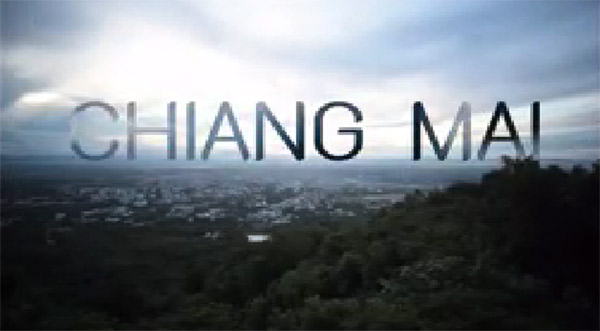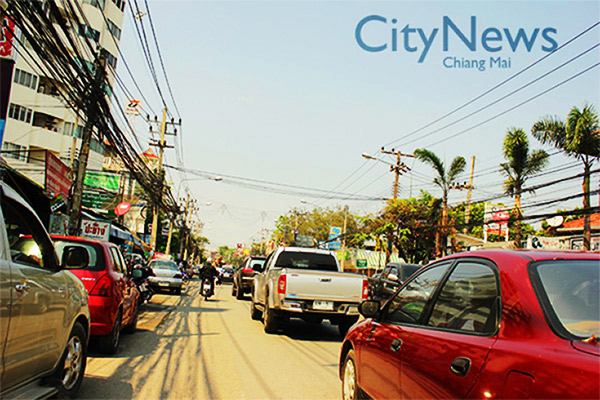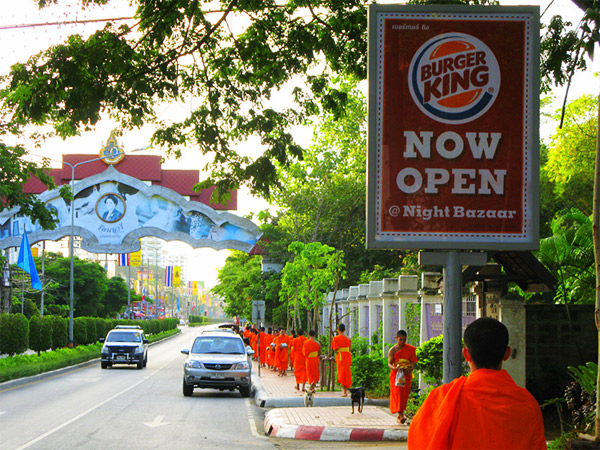 Screenshot from the World Bank Green Chiang Mai video
Screenshot from the World Bank Green Chiang Mai video
Chiang Mai, Rose of the North, the Garden City, has been under the industrial knife for quite a while. Progress – a manifold noun – is the buzzword accorded to Chiang Mai these days. Thailand’s arguably second most modern city is heading towards a much more developed, but perhaps divided future. No longer will any journalist ever call Chiang Mai “a sleepy backwater” as they so often did in the past. Recent developments maintaining the city’s rapid growth are more in line with the big city “bustling metropolis” epithet. This does not meet with everyone’s approval. Put the article (a) in front of ‘growth’ and the word becomes repellant.
This was written on our social media the other day:
“My beautiful city is more and more becoming fucking Bangkok 2.”
Strong words, and although this comment was relating to societal issues, not the environment, it has become clichéd these days to say that Chiang Mai is modeling itself – on the behalf of investors and developers, not residents – on the nation’s capital. While the explosion of business and commerce, technology, cultural modernization, might be a positive thing, the negative aspect of Bangkok: congestion, pollution, corruption, is the comparison many people are alluding to.
Bangkokians, I am told, are coming here en masse. My (Thai) friend who works in the rental and sale of property in Chiang Mai told me after I informed her of this story, “Many Bangkok people plan to move to here. A lot of my costumers are from Bangkok.” The housing and condo market is booming. According to the Department of Land more than 6,000 condo units have been built in the last two years. You only need to look around to see that this number will be much higher soon.
On the tails of the Bangkokians are the madding tourists, clambering into the Land of Smiles likes the zombies in World War Z. AOT’s statistics show a large increase (16%) in passengers, domestic and international (much bigger increase in international), that came during high season (Oct-Dec) from 2012-2013, and up 21.6% since 2010. This number is expected to increase even more. If we read TAT’s press releases this last year we might assume that the Indian market, as well as the Chinese, is the market currently being tapped. This is great news for the Thai economy, and perhaps even those Thai citizens waiting with open palms for all this progress to turn into money and trickle into their lives, but there are of course a lot of negative consequences. One such consequence, in Chiang Mai, is congestion, pollution, deteriorating conditions for pedestrian and bicycles, and perhaps over-stretches of the imagination to where you can fit a shopping mall or a condo… and noise, a lot more noise. We now know that no longer will flights over the city stop at midnight and start at 6 a.m. From now on planes will grace the Chiang Mai skyline around the clock. The spectre of traffic jams, and air pollution and noise has a lot of people concerned. As the Chinese and Bangkokians march in, any online discussion forum will tell you many people are also marching out, almost always stating the reason that their ‘garden city’ is starting to look more like a crowded driveway. Chiang Mai’s future progress may be cut short if something is not done about the lack of land and urban planning and the consequent over-development and its attendant congestion and pollution. So, when I first heard about the plans for Chiang Mai, the ‘Green City’, the future started looking brighter…or at least greener.
 Nimmanhaemin Road is rarely not congested
Nimmanhaemin Road is rarely not congested
The Green/Emerald City
The municipality is currently working on a green city initiative with The World Bank. In 2010 a GEF (Global Environmental Facility) 729, 630 USD grant was made available, via the World Bank as implementing agency, to make a start in making Chiang Mai a ‘Green City’, as part of a larger project focused on ‘sustainable urban transport’.
The GEF grant from international donors would be added to more money from local government funds (for a total of 2, 495, 110 USD) to create this new environmentally cool new look, replete with bicycle lanes and walking spaces. However, in view of the current physical changes that we have witnessed in Chiang Mai in the past few years, had this initiative been under the moniker ‘Concrete City’, it might have seemed more realistic. So what exactly is happening to Chiang Mai to make it greener?
The project coordinator. Dr. Chanin Manopiniwes, an Infrastructure Economist at the World Bank based in Bangkok, writes on his World Bank blog:
“To help, the World Bank is supporting the Chiang Mai Municipality’s vision of promoting “green mobility” with help from the Global Environment Facility (GEF). It is a small pilot project that supports non-motorized transport, such as walking and bicycling, by improving city center’s walk path and bicycle lanes in the city center …We will have pedestrian/bicycle-friendly recreation areas right in the heart of Chiang Mai city by early 2014.”
The plan has clearly yet to come to fruition, to say the least. The reason why it hasn’t is complicated, but that’s what I set out to find out.
Ricky Ward, a local environmentalist, had written quite a lot of critical comments on Chanin’s blog. One of those contained this:
“1. The project has nothing to do with improving cycling and walking and reducing pollution; 2: The so-called community consultation is a farce and the bank should either have made sure it was genuine or pulled the plug on it.”
Ward told CityNews that he was upset because he says consultations went ahead without members of the public being informed (a GEF grant is essentially international free public money that is made available to the World Bank and full accountability towards the stated objectives is therefore a must.)
What Ward is referring to when he talks about consultations is one particular major work that has been done since the ‘green city’ imitative started: The re-development at the Three Kings Monument Square.
Chanin writes on his blog about the consultation process:
“I believe that Chiang Mai Municipality reached out to community leaders to represent the people in the area and conducted the consultation in March 2013. The community around the project area also went to Chiang Mai Municipality to discuss the public consultation process. Since July 2013, Chiang Mai Municipality organized several more public consultation meetings with the communities (there were around 3-4 consultation sessions) until the change of the design was agreed with the communities in late September 2013.”
Ward, who attended one of the later meetings and reported that local shop owners around the Three Kings as well as local activists in the area were furious with the development and the fact they hadn’t been informed, skeptically replies to Chanin saying:
“We know what, ‘Chiang Mai Municipality reached out to community leaders’ means. It means talking to mates of the mayor and his clique.”
Ward also pointed out that such a huge initiative – in view of the city’s prolific public relations department – was kept quiet from the press. Here at CityNews for instance we were never informed of the possibility of this Green Chiang Mai, and neither can I find anything in the Thai press.
According to Ward the development has been to “…dig up recent paving at the Three Kings Monument and replace it with more fancy paving, avoid planting shady trees and having no effect on the ability to walk or cycle safely in the city.”
According to the city, the Three Kings Monument Square development was to create better walking spaces in this part of Chiang Mai.
 Moving city
Moving city
The important fact is that the GEF grant, which comes with strict guidelines, although approved, will not be disbursed if certain clear objectives in line with a green city and sustainable urban transport are not met. In fact, no money has been disbursed as yet, or at least this is what it says on the website. Because of this the disbursement date has been extended twice.
An amendment was recently made to the grant as well, after the city made an application asking that part of the money go to “training and workshops outside of Thailand”…So far however, it seems that practical plans related to making Chiang Mai greener, as shown in this World Bank promotional video, are either slow, or just very difficult to see.
I have written to Chanin twice so that he might better explain recent advances with the plan, but so far I have not yet received a reply. He did however write this on his blog:
“While clearly much more work will have to be done, we hope that this pilot project will start contributing to the use of non-motorized transport in Chiang Mai once completed.”
I was fortunate enough, however, to find and discuss these issues with L.E Marcon, a Doctor in transport engineering and economics, who has worked in, or for, International Financial Institutions for almost 30 years, and advised governments on the design, construction, financing and operation of major infrastructure projects in over 40 countries. Dr. Marcon, who knows very well the World Bank procedures, had also worked with GEF grants before, and so could better explain to me what is actually happening.
First he pointed me to where I could find a comprehensive account of the proposed plan for the development. The project, details of costs and grant support from the international community, in full, can be found at the Global Environmental Facility website under Thailand and World Bank Projects here and here.
He explained that GEF grant money is provided by many countries, mostly European, who have budgets going towards actions for environmental improvements. These contributions are usually collected in trust funds of billions of dollars and, for the implementation of projects and the actual grant disbursements, use “agencies” such as the World Bank. Funds, he says, are “free money”, that are given for “measurable improvements to the environment under precise, defined guidelines. The development of a sustainable urban transport system in Chiang Mai falls in full in this definition”
“I used GEF money,” he says, “so I know how it works.” Animatedly he adds, “It’s in fact a gift to Chiang Mai, a kiss of love for environmental improvements coming from many countries!”
As a long term resident of Chiang Mai and an expert in the field of urban transport, he supports the green city project. He explains that in 2003 GTZ (now GIZ: Deutsche Gesellschaft für Internationale Zusammenarbeit, the German cooperation agency who provide services for sustainable development), drew up a masterplan for the development of Chiang Mai’s Sustainable Urban Transport System, and in 2010 the World Bank came into this picture with a further initiative directed towards integrated land use and a sustainable urban transport, also including some concrete actions for the improvement of pedestrian and cycling routes in accordance with making Chiang Mai a green city. The city agreed to take the grant, and with part of its own funds, set out to develop this apparently excellent initiative.
The project implementation started in January 2012, for an implementation period of 1 ½ years, that is completion by mid-2013. But the disbursement deadline of the GEF grant had to be extended, and extended again. The reason for this, says Marcon, was likely because there was “no eligible expenditure under GEF rules.” Meaning that the initial objectives had not been met. The new disbursement date is now April 2014, which seems to short a time to achieve something concrete in the field.
For instance, one of the objectives in the plan, part of what’s called a “measurable performance indicator” for this project, was indeed that non-motorised transport, i.e. walking and bicycling, had to be increased from 4% to 10% within the old city. If this did not happen, with clear evidence of it happening, the disbursement of the GEF grant would not be fully justified. It still evidently hasn’t happened, as the transport situation is in fact getting much worse. But why?
Dr. Marcon explains that there are “two possible scenarios”. One is that the World Bank was unable to disburse the GEF grant under the GEF rules because the necessary action has not been taken to improve urban transport in accordance with the green city initiatives, and the other is that some money may have been spent, or is going to be spent, but not in line with the initial objectives.
“The Word Bank” he says, “may actually be embarrassed by the lack of concrete results so far in moving towards the initial project’s objectives to get the GEF grant for green mobility.”
This, he says, is a shame as Chiang Mai can improve greatly in terms of congestion and pollution with the help of these grants. “Grants,” he adds emphatically, “that can be awarded again and again if they are implemented right.”
“This can open the door to much more free money,” he says, “but plans have to be implemented in a sustainable, transparent, responsible, visible way, to improve the urban transport system in Chiang Mai.”
“It’s embarrassing if the municipality cannot find actions to justify disbursement, as people living in Chiang Mai could easily come up with a long list” he says. It is actually the responsibly of the municipality to meet the initial objectives of the project.
Dr. Marcon still has hopes for this vision of a green Chiang Mai, but he also has misgivings about certain developments in the city of which he says seem sometimes to follow “no urban and transport masterplan, no vision for the future and no strategic direction to address rising urban transport challenges.”
He expresses, as an example, how beautiful Acapulco once was, but how harmful developments led to the destruction of the city. “This might happen also here,” he says, if the developers and local government do not follow certain environmentally conscious guidelines. “This small GEF and World Bank project was only an initial step to try to move Chiang Mai towards a more sustainable development, which is essential for the city’s historical areas,” he finally says.
Chiang Mai’s future as a rose, and a popular tourist attraction, leans on this responsible development. The city can be helped greatly with proposals and actions in the field and – if you read the full project plan – the intelligent ideas to create a green Chiang Mai as initially developed for this project. It remains now to be seen how things will unfold, how green or less green Chiang Mai will become. Is it possible that our Green city will turn out to be as real as the The Emerald City?
 Editor
Editor
James Austin Farrell